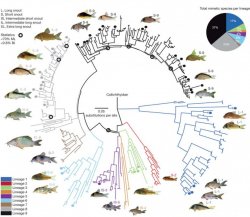When one is dealing with ichthyology, one has to use the correct terms because they can be very specialized in meaning. Sometimes it is just not possible to say the same thing differently. Ask any questions you have, always.
Yes. There are now over 160 described species (and dozens still undescribed) in the present genus Corydoras, and I think there cannot be the slightest doubt (because of several phylogenetic studies all reaching basically the same conclusions) that these species are not all related in the same way, simply because they have evolved separately from at least nine different ancestors.
The separate phylogenetic analyses by Britto (2003) and Alexandrou et al (2011) both discerned nine lineages. This means there are nine different fish that evolved into the 200 or so "cory" species we have discovered living in South America. And when we speak of "ancestor" here, we mean the last species that directly evolved into the existing species. Fish are still evolving, creating new species, but they can be traced back to the one species that started each lineage on this road, and that is the ancestor.
Corydoras panda and C. melini are in the same lineage, so they evolved from the same ancestor cory-like fish. C. paleatus (you mention this pepper cory further on) evolved from a completely different ancestor fish, so it is still in the subfamily Corydoradinae, but it is not as closely related to C. panda as is C. melini. One of the reasons many aquarists are interested in this scientific side is that we can learn a great deal about a species if we know something about its closest ancestors. This is because the specific traits that make up a species will be common to all species in that same genus, if it is a monophyletic clade. I'll come back to this idea when mentioning Scleromystax below.
I mentioned C. adolfoi and C. sterbai are also presumed to be in Lineage 9 (Alexandrou & Taylor, 2011). I find this interesting, because in my 115g tank I have a group of these two species, four of each. The C. adolfoi I know have spawned, because I found a fry in the canister filter once, and it is now the same size as the adults. But on many occasions I have observed a C. adolfoi going through very definite pre-spawning actions with a C. sterbai, so the fact that they are so closely related is likely significant.
This is very different from "play" behaviour, such as I see with other species. Different species, or individuals from different species, "hanging out" with other species is something I would suggest one can expect to see with any of the corys. They are after all in the same Tribe in the same subfamily. And we know that "aggression" in corys is almost non-existant. The species that are now in the genus Scleromystax though are not so docile. S. barbatus, which prior to Britto (2003) was considered Corydoras barbatus, can show considerable aggression to others in the species, and even other fish. This trait is also evident in the five or six other Scleromystax species, so here again we have an example of the benefit of getting the taxonomy correct--we can assume how a new Scleromystax species is likely to behave.
Byron.
So the long and the short of it - in easy to understand terms - is that several cory species are related (my panda's and melini being one of them) and then there's another different type of cory which also has other types related to them ... have I understood that right?
Yes. There are now over 160 described species (and dozens still undescribed) in the present genus Corydoras, and I think there cannot be the slightest doubt (because of several phylogenetic studies all reaching basically the same conclusions) that these species are not all related in the same way, simply because they have evolved separately from at least nine different ancestors.
The separate phylogenetic analyses by Britto (2003) and Alexandrou et al (2011) both discerned nine lineages. This means there are nine different fish that evolved into the 200 or so "cory" species we have discovered living in South America. And when we speak of "ancestor" here, we mean the last species that directly evolved into the existing species. Fish are still evolving, creating new species, but they can be traced back to the one species that started each lineage on this road, and that is the ancestor.
Corydoras panda and C. melini are in the same lineage, so they evolved from the same ancestor cory-like fish. C. paleatus (you mention this pepper cory further on) evolved from a completely different ancestor fish, so it is still in the subfamily Corydoradinae, but it is not as closely related to C. panda as is C. melini. One of the reasons many aquarists are interested in this scientific side is that we can learn a great deal about a species if we know something about its closest ancestors. This is because the specific traits that make up a species will be common to all species in that same genus, if it is a monophyletic clade. I'll come back to this idea when mentioning Scleromystax below.
I mentioned C. adolfoi and C. sterbai are also presumed to be in Lineage 9 (Alexandrou & Taylor, 2011). I find this interesting, because in my 115g tank I have a group of these two species, four of each. The C. adolfoi I know have spawned, because I found a fry in the canister filter once, and it is now the same size as the adults. But on many occasions I have observed a C. adolfoi going through very definite pre-spawning actions with a C. sterbai, so the fact that they are so closely related is likely significant.
This is very different from "play" behaviour, such as I see with other species. Different species, or individuals from different species, "hanging out" with other species is something I would suggest one can expect to see with any of the corys. They are after all in the same Tribe in the same subfamily. And we know that "aggression" in corys is almost non-existant. The species that are now in the genus Scleromystax though are not so docile. S. barbatus, which prior to Britto (2003) was considered Corydoras barbatus, can show considerable aggression to others in the species, and even other fish. This trait is also evident in the five or six other Scleromystax species, so here again we have an example of the benefit of getting the taxonomy correct--we can assume how a new Scleromystax species is likely to behave.
Byron.





